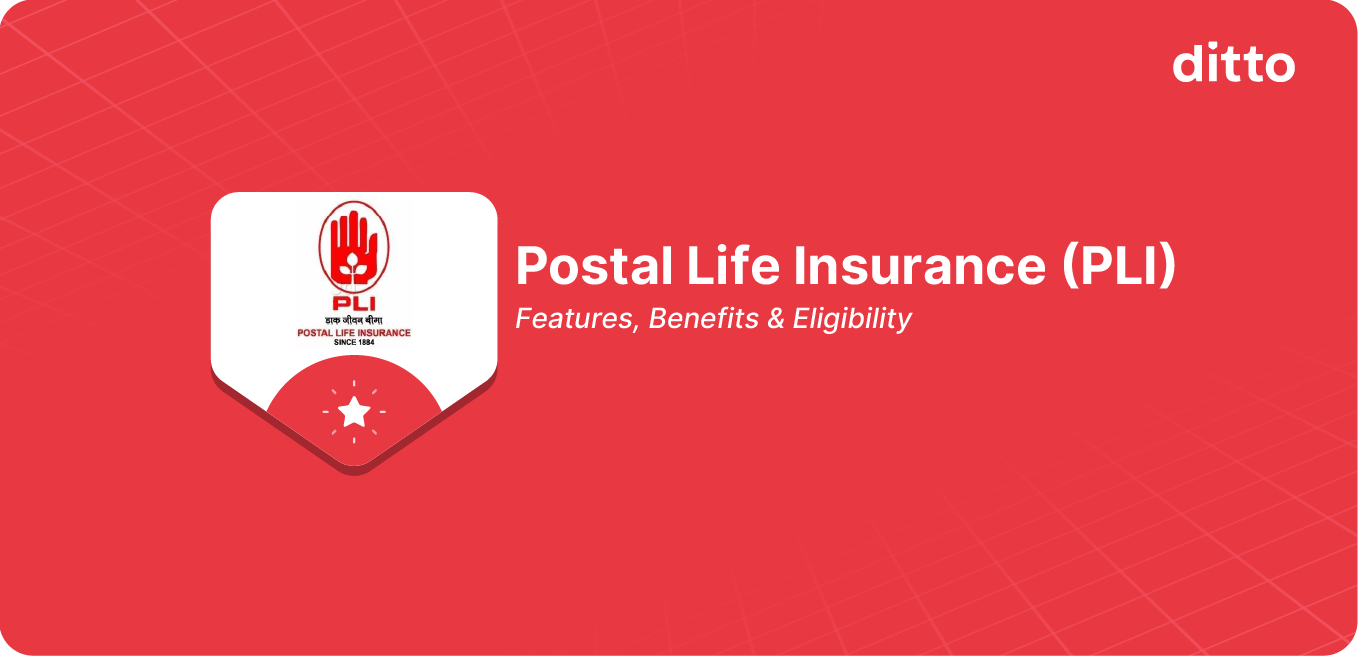What is Postal Life Insurance (PLI)?
Postal Life Insurance (PLI) is one of India's oldest life insurance schemes. Established in 1884, it holds a legacy of trust. While it started as a welfare program for postal employees, Postal Life Insurance has continually expanded its scope. But is this traditional scheme the right fit for your family’s future? Let's explore everything about Postal Life Insurance and how it stacks up against modern protection plans.
What Does Postal Life Insurance Mean?
Postal Life Insurance is a life cover scheme offered by the Department of Posts (India Post). Unlike pure insurance products, Postal Life Insurance policies are traditional whole-life and endowment plans. This means they are designed for two purposes: to provide a sum to your nominee if you pass away, and to pay out a corpus (sum assured + Bonus) if you survive the policy term.
Features of Postal Life Insurance
Government-Backed Security
Competitive Premiums & High Returns
Loan Facility
Tax Benefits

Eligibility: Who Can Buy Postal Life Insurance?
Primary Group:
Employees of Central and State Governments, Defence personnel, Public Sector Undertakings (PSUs), and Nationalized Banks.
Professionals & Private Sector:
Doctors, Engineers, CAs, Lawyers, and employees of companies listed on the NSE/BSE.
The Latest Expansion:
Critically, all graduates and diploma holders from recognized institutions are now eligible to purchase Postal Life Insurance.
General Age Criteria:
Minimum entry age is generally 19 years, and the maximum entry age varies by scheme (up to 50-55 years).
Minimum and Maximum Sum Assured:
₹20,000 and ₹50 Lakh.
What Schemes Are Available Under Postal Life Insurance?
Postal Life Insurance offers six distinct plans, each tailored for different financial goals:
1. Suraksha (Whole Life Assurance - WLA)
Suraksha is a This lifelong protection plan that pays the sum assured plus bonuses at age 80 or to beneficiaries on death, as long as the policy is active.
The policy offers loans after four years and can be surrendered after three years (no bonus is paid if surrendered before 5 years). Premiums can be paid up to age 55, 58, or 60, and the plan can be converted to an Endowment Assurance Policy up to age 59. On surrender, a proportionate bonus on the reduced sum assured is paid.
2. Santosh (Endowment Assurance - EA)
This plan offers guaranteed protection along with savings and pays the full sum assured plus bonuses when the insured reaches the chosen maturity age: 35, 40, 45, 50, 55, 58, or 60 years.
If the insured passes away earlier, the nominee or legal heir receives the complete sum assured along with accrued bonuses. Loans can be taken after three years and the policy can be surrendered after three years. Bonuses are only paid proportionally if surrendered after five years.
3. Suvidha (Convertible Whole Life Assurance - CWLA)
The plan offers lifelong coverage with the option to convert the policy into an Endowment Assurance after five years (but before completing 6 years from the date of commencement). If not converted, it continues as a regular Whole Life Assurance policy.
It pays the full sum assured plus accrued bonuses either on maturity or to the nominee in case of the insured’s death. The plan is available for ages 19–50. It offers loans after four years and can be surrendered after three years. No bonus is paid if surrendered before five years.
4. Sumangal (Anticipated Endowment Assurance - AEA)
Sumangal is a money-back policy ideal for those who prefer periodic returns. It provides survival benefits at fixed intervals. If the insured passes away before maturity, previously paid survival amounts are ignored and the nominee receives the full sum assured plus bonuses.
The policy is available for 15- and 20-year terms, with entry ages up to 45 years for the 15-year term and 40 years for the 20-year term. Survival payouts are 20% each at 6, 9, and 12 years for the 15-year plan and at 8, 12, and 16 years for the 20-year plan, with the remaining 40% plus accrued bonuses paid at maturity.
5. Yugal Suraksha (Joint Life Assurance)
This policy is specifically designed for married couples. It is offered on the condition that at least one spouse is eligible for PLI. Both partners are required to be 21–45 years old and the elder spouse not above 45.
The policy term ranges from 5 to 20 years and includes loan and surrender options after three years. The policy pays the sum assured plus bonus upon the first death of either spouse, at which point the policy terminates, or if both survive, the benefit is paid at maturity.
6. Bal Jeevan Bima (Children Policy)
This scheme allows PLI policyholders to secure the future of their children (maximum of two). The policyholder must be under the age of 45 to purchase it for a child aged 5 to 20 years.
A key feature is the premium waiver: if the parent (policyholder) passes away, no further premiums are required for the child's policy, but the policy continues to run and pays the full benefit upon its maturity. The policy cannot be surrendered or used for loans but can be made paid-up after five years of continuous premiums.
Bonus in Postal Life Insurance: How It Works & Latest Rates
PLI offers the unique benefit of an annual bonus added to your policy. The Department of Posts declares the bonus every year. The bonus is calculated per ₹1,000 of the sum assured and accumulates over the years. The accumulated bonus is paid along with the sum assured at maturity or in the event of death. Rates vary annually but, once declared, become vested.
Note on Suvidha: The bonus rate for the Convertible Whole Life Assurance (Suvidha) is ₹60 per ₹1,000 of sum assured. If the policy is converted into an Endowment Assurance policy, a reduced bonus rate of ₹48 per ₹1,000 of sum assured will apply.
Postal Life Insurance vs Standard Term Insurance: Key Differences
Why Choose Ditto for Life Insurance?
At Ditto, we’ve assisted over 8,00,000 customers with choosing the right insurance policy. Why customers like Aaron below love us:

- No-Spam & No Salesmen
- Rated 4.9/5 on Google Reviews by 15,000+ happy customers
- Backed by Zerodha
- 100% Free Consultation
You can book a FREE consultation. Slots are running out, so make sure you book a call now!
Final Thoughts
Postal Life Insurance is a trusted, long-standing option that offers safe life cover along with savings, backed by India Post. For those eligible, it can be a solid part of your financial plan. But it’s important to note its limits, especially the lower coverage cap.
If you have major responsibilities like a home loan, young kids, or dependent parents, you’ll likely need higher protection. That’s where term insurance becomes essential.
A good private term plan gives you large, affordable coverage and is a must if your family depends on you.
Frequently Asked Questions
Last updated on:










